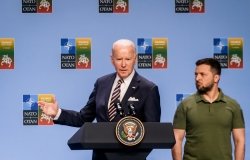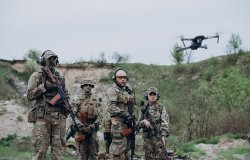
A blog of the Kennan Institute
Defense Technology Investment in Ukraine Is Attractive but Awaits Greater Risk Insurance
The development of Ukrainian defense industry technologies in response to Russian missile and drone attacks has led to the revival of Ukraine's defense technological and industrial base (DTIB) after decades of decline. It seems clear that Ukraine will have to rely on technology to withstand an aggressor with four times more draftable conscripts to call on. The United States would benefit economically and in the acquisition of advanced military technology by cooperating with Ukraine in joint defense industry ventures.
The Boom in Armaments Technology
In 2023, the Ukrainian defense industry produced weapons and equipment worth $3 billion, adding 1.5 percent to the country’s GDP growth. Over the past year, the largest state-owned industry holding, Ukrainian Defense Industry JSC, boosted its production by 92 percent, but it now lags behind local, privately owned defense enterprises, especially with respect to R&D. For example, nine out of ten long-range drone manufacturers are private players.
Ukraine, with over 100 different drone models developed and customized locally for the military’s needs by more than 200 Ukrainian manufacturers, greatly outperforms Russia in this arena. Ukraine’s Sea Baby maritime drone, largely produced through private R&D, has already destroyed one-third of the Russian fleet in the Black Sea, forcing the remaining vessels out of Russia’s naval base in Sevastopol.
The need to increase weapons production has become increasingly urgent, however, as Putin boosts Russia’s military production with additional budget allocations and mobilizes hundreds of thousands of new soldiers. These moves threaten not only Ukraine but also the EU and NATO—hence the United States.
President Zelensky has proposed a target of one million drones produced annually by Ukraine, a figure barely feasible without considerably greater foreign capital investment in drone production. Sustaining the great number of arms variants and integrating these military technologies has become a challenge for the Ukrainian army.
Proven success in such integration so far has made Ukraine the world center for the testing and practical application of modern weapons. Nonstop front-line data collection has aided Ukraine in becoming a global leader in technology development. The practical application of big data takes place in real time that otherwise would take years and tens of billions of dollars just to replicate the data sources needed for such R&D.
Ukraine’s weapon supply needs have also undergone changes. Whereas in early 2022, old Soviet-standard ammo, tanks, and artillery were employed to support Ukraine’s defense, with a subsequent shift toward post-World War II stocks, today newly manufactured, modern NATO-standard weapons are arriving at the front.
Can Localized Coproduction Be Achieved Quickly?
Last year, cooperation in the defense sphere between Ukraine and the United States reached a new level. The White House announced it wanted Ukraine to be a partner in joint production and would provide the necessary technology transfers for military R&D and production.
Sealing the deal, in December 2023 the United States and Ukraine signed a declaration on joint weapons manufacturing, including the production of hybrid air defense systems within the FrankenSAM program, which combines advanced Western technology and Soviet-era weapons stockpiles, with possible technology transfer for Ukraine. (An early test of the combined weapon system in January 2024 was successful.)
A special tri-departmental interagency group, the Ukraine Deal Team, has begun operating. Its task is to work on potential deals and craft the U.S. response in respect to export requirements.
Ukraine has a distinct presence in military technology and can quickly adapt to joint weapons production with American DTIB players, starting with licensed manufacturing and moving toward common R&D. Still, despite the deal looking favorable, some conflict risk mitigation protection is needed to stimulate such U.S. investment. Three ways of providing such protection are commonly discussed.
1. Insurance of investments for defense industry enterprises
One way to derisk cooperative DTIB investments is to provide investment insurance, but no existing programs covering DTIB military risk are available now. Conflict risk coverage needs to be created for U.S. DTIB investments.
Such coverage could be formulated along the lines of the successful non-DTIB investment insurance developed several years ago by the U.S. International Development Finance Corporation, and the insurance programs developed by the World Bank’s Multilateral Investment Guarantee Agency. Both programs could be a model for the DTIB sector.
2. New Lend-Lease DTIB equipment-targeted program
The U.S. Ukraine Democracy Defense Lend-Lease Act, passed on April 28, 2022, could have helped in this regard. Despite its advantages, however, it was not used by the U.S. administration in fiscal 2023 and was allowed to expire on September 30, 2023. The White House prefers other support programs for Ukraine, such as the Presidential Drawdown Authority (allowing the president to deliver services and equipment quickly from U.S. stocks), the IMF’s Extended Fund Facility (which provides funds to support Ukraine economically), and the Ukraine Security Assistance Initiative, operating under the U.S. Department of Defense (which provides funds for training and equipment to build Ukraine’s defense capacity).
An alternative approach would be to revisit lend-lease arrangements to support commercial leasing of the equipment needed for weapons and ammunition production. This could be crucial to meeting the massive CAPEX needs (capital expenditures, used to acquire and maintain hard physical assets) for the joint ventures suggested above to ramp up production quickly in high volumes.
The lend-lease mechanism proved successful during World War II. The difference now is that leasing can be provided on a paid basis for the private sector, avoiding the additional sovereign-country-risk liability burden for Ukraine.
3. Diversified demand for long-term agreements
The Ukrainian army’s needs for modern weaponry and EU and NATO members’ needs to replenish, modernize, and expand their own stockpiles will support such cross-border joint ventures with Ukrainian firms.
Long-term off-take contracts both from Ukraine and allied states are also needed but will become practical only if military technology conflict insurance can be offered for investments. The intense local combat and probable future instability both in the region and globally means that demand for DTIB products will likely remain high for decades.
Potential Outcomes
DTIB is a long-term priority of the Ukrainian government. In the future, it should lead to the development of a more technologically competent workforce and experienced engineers. The country’s high-tech military sector will develop quickly. It would also ensure that manufacturing in Ukraine through joint ventures would be cheaper, rewarding the United States well for its involvement. And the joint venture production would be a form of economic assistance that would reduce the need for direct U.S. support.
All the ingredients are in place for U.S.-Ukraine coproduction now. Needed are some facilitators, such as DTIB conflict insurance, to get it rolling. Special legal protections and tax regimes for joint military technology projects would also encourage quick action. It's time to move forward on these projects.
The opinions expressed in this article are those solely of the author and do not reflect the views of the Kennan Institute.
See our newest content first.
Subscribe to receive the latest analysis from Focus Ukraine
About the Author

Halyna Yanchenko

Kennan Institute
The Kennan Institute is the premier US center for advanced research on Russia and Eurasia and the oldest and largest regional program at the Woodrow Wilson International Center for Scholars. The Kennan Institute is committed to improving American understanding of Russia, Ukraine, Central Asia, the Caucasus, and the surrounding region though research and exchange. Read more











